Nashville And Bobbing Black Cats
Posted by: Loren Coleman on January 6th, 2007
Nashville Cats, play clean as country water
Nashville Cats, play wild as mountain dew
Nashville Cats, been playin’ since they’s babies
Nashville Cats, get work before they’re two
— by John B. Sebastian, Lovin’ Spoonful, 1967.
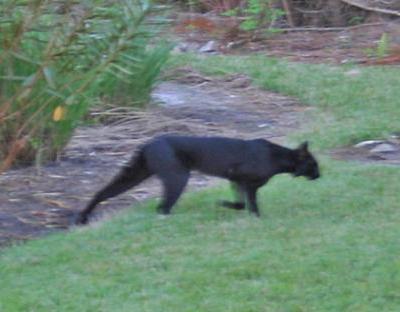
Is this cryptid black cat a melanistic bobcat (Lynx rufus/Felis rufus)?
Back on November 19, 2006, I wrote about the sightings and then videotape of a large short-tailed cat seen in Nashville, Tennessee. Speculations covered caracal, lynx, and bobcat.
The two images below are from the video taken of the Tennessee Mystery Cat:
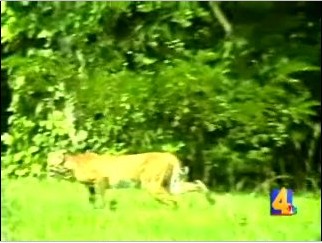
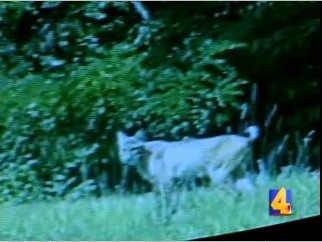
Ben Willis of Bigcats.org brings to my attention that a road-killed 44 pound bobcat (see below) was found along a major highway near Camp Lejeune, North Carolina. The specimen, Willis feels, closely resembles the cat videographed at Nashville.
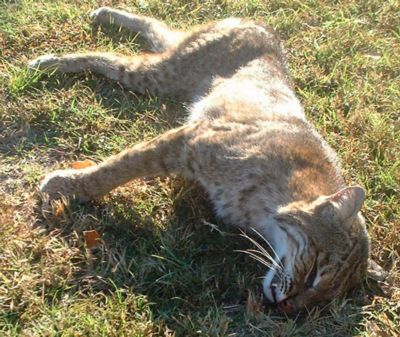
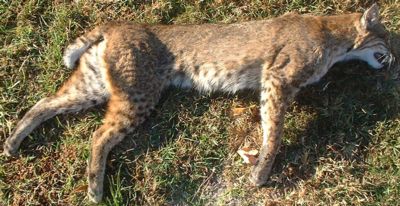
In a new article about bobcats, posted by Chad Arment on his Strange Ark research list, some confusing statements are shared by the author Frank Sargeant. Sargeant says that despite his hearing from people in Florida that they are seeing a "panther," he thinks they are seeing bobcats. He comments:
Bobcats are nowhere near the size of panthers; they weigh only about 25 pounds, typically, compared to 80 to 120 pounds for a panther. They’re only about three feet long, while the panther’s tail is that length. The bobcat is named for its "bobbed" tail, which is only about 6 inches long. And they wear black spots over a tawny brown to tan coat.
Panthers are a solid brown or tan, with no spots. And they are not black, period. Many of the calls I get describe "black panthers," but the biologists say it just is not a possibility. There has never been a single valid incidence of a black panther in Florida, nor in the general cougar population of North America….
Frank Sargeant concluded:
If you see a big black critter in the woods, it’s probably a Labrador retriever – or maybe a wild hog.
But what Sargeant ignores is a well-known existing population of black bobcats, one of which may be represented in the photograph taken in Florida (above). This animal was caught on film recently by a university professor from Georgia and shared with me by Ben Willis. It is posted at the top of this blog. If it is a melanistic bobcat, it would be a Lynx rufus floridanus (a/k/a Felis rufus floridanus)
Stanley P. Young’s 1958 bible on the animal, The Bobcat of North America documents the Southern pockets of black bobcats and has a photograph of one of them in captivity.
In 1978, I saw a black bobcat crossing a road near the edge of the Everglades National Park, while I was doing fieldwork on the Skunk Ape. Sometimes when you go looking for one thing, you can be rewarded with other remarkable experiences.
About Loren Coleman
Loren Coleman is one of the world’s leading cryptozoologists, some say “the” leading living cryptozoologist. Certainly, he is acknowledged as the current living American researcher and writer who has most popularized cryptozoology in the late 20th and early 21st centuries.
Starting his fieldwork and investigations in 1960, after traveling and trekking extensively in pursuit of cryptozoological mysteries, Coleman began writing to share his experiences in 1969. An honorary member of Ivan T. Sanderson’s Society for the Investigation of the Unexplained in the 1970s, Coleman has been bestowed with similar honorary memberships of the North Idaho College Cryptozoology Club in 1983, and in subsequent years, that of the British Columbia Scientific Cryptozoology Club, CryptoSafari International, and other international organizations. He was also a Life Member and Benefactor of the International Society of Cryptozoology (now-defunct).
Loren Coleman’s daily blog, as a member of the Cryptomundo Team, served as an ongoing avenue of communication for the ever-growing body of cryptozoo news from 2005 through 2013. He returned as an infrequent contributor beginning Halloween week of 2015.
Coleman is the founder in 2003, and current director of the International Cryptozoology Museum in Portland, Maine.










The black one: not even the stub-tail of a bobcat. Is this the first manx ABC? 🙂
The yellow tint on picture 2 makes it look puma-ish, but the tail gives it away. I think pictures 2 and 3 are of bobcats.
Very funny. But not a cryptid manx.
Regarding the black cat, the tail may be there, just next to the body, as does occur in lynxes and bobcats, but harder to see because the felid is melanistic. I think I see a hint of the tail, against the back leg.
Look closely at the facial turfs, which are rather diagnostic of a bobcat.
Here’s a NOAA photo of a normal color phase bobcat from Florida, in which you can begin to see how the tail is sometimes combined with the leg in photos. In a swiftly moving black cat, this effect could appear more deceptive.
Note the tufts too, which are not there in domestic cats.
The first photograph — from the size suggested by proportion against the landscape plants, the long, long legs (even the ones that aren’t extended), the shape of the ears, the lean body, and the head shape — all suggest another Burmese housecat(or hybrid thereof) to me. I don’t know if this critter has his tail to the opposite side to we can’t see it, or it’s missing completely, but I think it would be long and housecat-like.
Once again, a Burmese, while definitely a black domestic cat, does not have the same build as this photographed Florida black mystery cat and does not have muttonchops on its cheeks. This felid does. Those are diagnostic and should not be ignored.
Pretty kitty!
If you take a look at the farther back leg in the top picture you can just make out the tail. That’s definately a black bobcat.
Thanks for the quote from the Lovin’ Spoonful, always enjoyed their stuff.
I agree it does look like a black bobcat.
Bet there aren’t many of those around.
Hi Loren – good information here but I wanted to bring up that certain breeds of domestic cats DO have the “Bobcat mutton chops”, a good example is the Maine Coon Cat, it has the tufts, large head, and wide nose along with a body size that can be close to that of a bobcat. Other than the typical tail of this breed, the face and body could remind one of a bobcat. I’m not trying to suggest that the Florida photo is this breed, just that without any other evidence, domestic cats should not be so readily dismissed.
There is have a huge bobcat that hangs around my neighborhood and feasts on the various rabbits and ducks that abound here. The cat is seen about once a month zipping across my yard and up the ridge. This cat has to be go 40+ pounds.
I think that as bobcats go, these well-fed ones that live closer to people and have a steady diet grow bigger than the norm and get mistaken for cougars and other cryptid cats. As I also firmly believe, critters look bigger through the windshield and grow to gigantic proportions every time we tell about them.
I wonder how widespread black or darker colored bobs are, or are they limited to small pockets in the deep South.
I saw a large black cat as a kid in the everglades. Of course, I was a kid and I could have had an overactive imagination
Yes, I know all about Maine Coon Cats. I once raised them, bred them, and sadly saw most of my cats (silver classic tabby and black Maine Coon Cats) killed by feline leukemia in the mid-1970s. I had two Maine Coon Cats (Luna and Desert) rescued from a Mt. Desert Island shelter on a full moon night (thus their names) throughtout the 1980s and 1990s. They were good friends with my Australian Shepherd-German Shepherd dog, Duncan. All are gone now, but I do know a bit about this breed.
Distinctive features of Maine Coon Cats are tufts from their ears, sometimes tufts from between their toes, and in a few examples tufts on the face (which are combed to an enhanced appearance by breeders). But Maine Coon Cats are long-haired cats, and not close, at all, to the height, body structure, or the hair length of a bobcat.
Show standard Maine Coon Cats usually have the classic tabby or the regular tabby pattern. Even full-black Maine Coon Cats do not match black bobcats:
Well-groomed Maine Coon Cat with minor facial tufts
Black Maine Coon Cat with generalized long facial hair
Show-quality Maine Coon Cat, total body picture (does not look like a bobcat)
Joppa writes: “I wonder how widespread black or darker colored bobs are, or are they limited to small pockets in the deep South.”
Oh no, I feel I might have, from deep inside of me, a new list, “The Top Five Locations to Find Black Bobcats,” coming on…
In the first photo of the black cat, the cheek tufts are exactly like a bobcat’s and the head looks generally so.
What gets me is that the creature is rather lanky and elongated, almost like a greyhound in the belly and in the hindquarters–but some hungry bobcats turn out that way. It does not look like a puma. I do think I can see the hint of a short stumpy tail as well (it looks rather streaked with lighter color and does turn up at the end), and the animal does not have the face of a domestic cat. The more normal-colored Nashville cat from the video is much of the same body conformation.
Yes, I appreciated the Lovin’ Spoonful reference as well.
Those are some very handsome Maine Coon cats you have pictured there. I was familiar with the breed from past experience myself.
Loren, again you are correct and as I said I’m not trying to say that the photo depicts this breed per se. However, I had a Maine Coon cross when I was a kid, he had short body hair and the standard bushy tail – The way that I met Joe is why I’m mentioning this! I was about 10 when I turned around in the front yard and froze because I at first thought the cat sitting in front of me was a bobcat! He had huge mutton chops, a very wide nose and large face – It wasn’t until I saw the long tail that I realized that it was just a domestic cat. My cat Joe was very large – for a domestic cat, and I’m sure that a fleeting glimpse of him could have fooled someone not familiar with bobcats. Of course, he was the friendliest cat on earth!
Loren, I look forward to the list of black bob locations! Great discussion on cat breeds and bobcats.
Black bobcats are known to occur (rarely) in southern Florida; in fact the only documented specimens (about ten) were from southern Florida. The black cat in the photo here is certainly proportioned more like a bobcat than a housecat.
There are three other possibilities that come to my mind: servals, caracals, and jungle cats all have black phases, which are locally common in parts of their ranges. Of course, none of those species is native to Florida. But there are a LOT of exotic pet dealers and breeders in Florida, and not all of them are scrupulous in reporting animal escapes.
There are also quite a few people involved in breeding various small wild cats species with domestic cats, and with other species of small cats, to try to create new hybrid breeds.
Neither servals, caracals, nor jungle cats tend to have cheek ruffs, and the cat in this picture looks like it does have cheek ruffs. The cat also looks like it is proportioned more like a bobcat or caracal than a like a serval or jungle cat. And I think that a caracals ears would be longer, and have longer tassels, than this cat’s ears.
It looks like a bobcat to me. If it is indeed a black bobcat and not an artificially colored photo, it is a rare sight.
Yes Loren this a great photo of what is more then likely a melanistic bobcat.
Wow, must admit to never having even thought about a black phase bobcat! Neat. I’ve spent some time in the backwoods of FL and have seen a few bobcats (no panthers yet -darn), all had the stereotype coloration and were small, maybe in the 20LB average. I’ve seen some bobcats in wildlife parks that were MUCH larger, at least two times bigger, so the 44 pounder sounds reasonable to me.
Black is a good color for predators in certain habitats, sounds like it’s working out for the black bobcats in some places. Hopefully there will always be a few around.
Don’t know what to think about this kool kitty! I can only remember the cats at my grandmother’s house. Sseemed like there were always at least 10 to 15 running around there. I remember how many different looking, shaped, and sized cats there were. Seems like those cats only took a reproductive backseat to the bunnies out in the pastures. Anyways, this kitty is kool!
Sightings of black or melanistic creatures is on the rise, panthers, bobcat, whitetail deer, BF.
Please see the January 14th updated version:
Top Twelve Black Bobcat Hot Spots
It now notes the specific best dozen locations to go find these melanistic felids.
My husband and I saw a wild cat like this in our Barboursville WV neighborhood. The one we saw had a long black tail. In this picture above you either can’t see the tail or it doesn’t have one.